Welcome to the 11th edition of First Nations News & Views. This weekly series is one element in the “Invisible Indians” project put together by navajo and me, with assistance from the Native American Netroots Group. Last week’s edition is here. In this edition you will find a review of the Oklahoma Painters exhibit at the Grand Palais in Paris, a look at the year 1883 in American Indian history, the first in a series on the attempt to steal Hopi and Navajo water resources, the $1 billion government settlement with 41 tribes, an eye-rolling take on an Indian “party theme” and a baker’s dozen of linkable news bullets. Click on any of the headlines below to take you directly to that section of News & Views or to any of our earlier editions.
By navajo
Last November, an art exhibit titled Oklahoma Painters was presented at the prestigious Grand Palais in Paris as part of the sixth annual Art en Capital event. Eleven American Indian artists were featured. The exhibit is the first major one of its kind in Paris since the Kiowa Five were featured in the 1920s. It was curated by Russell Tallchief (Osage), director of Arts & Exhibitions at the American Indian Cultural Center & Museum in Oklahoma City.
Many visitors were intrigued by the modern display of art from American Indians, their expectations having been influenced by the romantic and stereotypical vision that Hollywood movies and the photos of Edward Curtis perpetuate throughout the world. Surprised, some commented about the variety of style among the artists as they had anticipated one uniform product from a unified culture. Instead they were exposed to contemporary pieces from the youth to the elders of various tribes, defining the uniqueness of individuals and their cultures.
The featured artists hail from 10 different tribes in Oklahoma:
Hock E Aye Vi – Edgar Heap of Birds (Cheyenne/Arapaho)
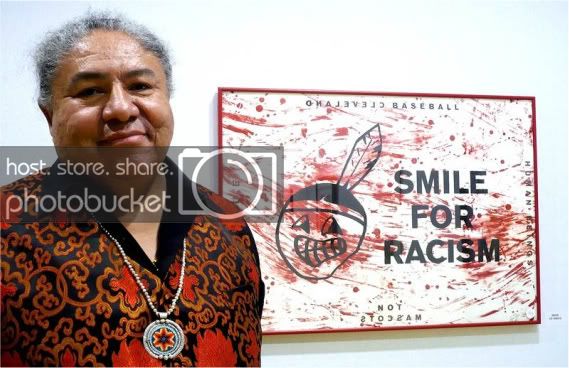
Photo courtesy of Dominque Godreche
(Note the backward words: Cleveland and Mascots)
Born in 1954 in Wichita, Kan., Heap of Birds studied at Haskell Indian School in Lawrence. He took a B.F.A. from the University of Kansas, an M.F.A from Temple University and then studied at the Royal College of Art, in London. Since 1988, he has served on the faculty at the University of Oklahoma as professor of Native American Studies. “Heap of Birds has exhibited internationally in the diverse mediums of signage, monumental sculpture, painting, print, drawing and installation.”
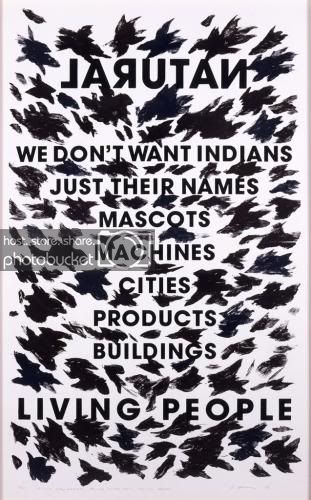
Telling Black Wolf,
Telling Hachivi
[Hachivi, his Cheyenne name, “Little Chief”]
~The artist explains that the backward
word NATURAL means
that it’s not.
He has exhibited at the Museum of Modern Art, Whitney Museum, Smithsonian National Museum of the American Indian, and other institutions such as the Australian Museum of Contemporary Art, Documenta in Kassel, Germany, the Bandung Institution of Technology in Indonesia, the Venice Biennale in Italy, and now the Grand Palais in France.
To my eye, his most impressive installation is theWheel sculpture at the Denver Art Museum, which is named for the symbolic medicine wheel. The project took 10 years to complete. Ten red porcelain-covered, steel-forked trees have been placed in a 50-foot circle and inscribed with references to “extermination, ancient pictography, astrological bodies and pillars of shared understanding like respect, encapsulating the interconnectivity of Indigenous science and philosophy. The positioning and writing of this installation mark millennia of Indigenous knowledge, systematically intervened to commemorate nuanced views of colonial policy and global Indigenous cooperation. The sculpture itself is aligned with astrological bodies.” On the summer solstice the sun rises between two of the forked panels.
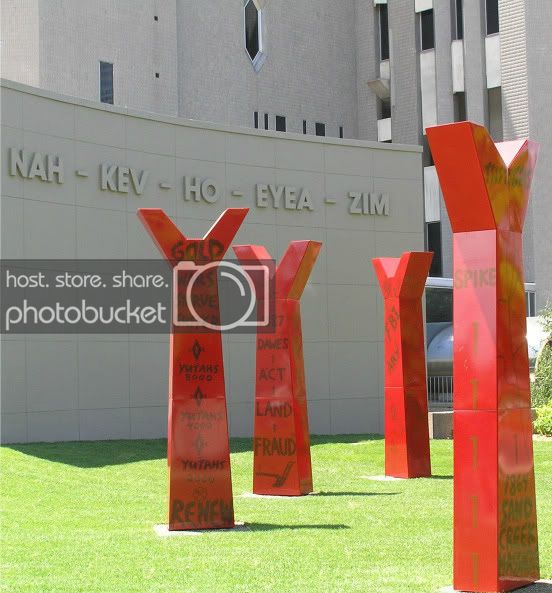
is Heap of Birds’s grandmother’s proverb of how Indians
never leave home in their minds, which translates as
“We are always returning back home again.”
In the on-line hEyOkA mAgAzInE, he gives a thought-provoking interview explaining the various messages and meanings of the installation.
He negotiated a 100-year contract to control the land under the installation which was part of the first land that the southern Cheyenne and Arapaho lost in the Fort Laramie Treaty of 1851. The genocide of these tribes began with the Massacre at Sand Creek in Kiowa County, Colo., in 1864. The southern Cheyenne and Arapaho were then moved out of Colorado to Kansas and Indian Territory (now Oklahoma). Heap of Birds’s tribes have reclaimed the land in Denver with this sculpture. By using his grandmother’s proverb on the wall next to the Wheel, they have taken back the sacred circle.
Tribal chiefs came for the dedication of the Wheel in June 2005. The tribes now use the site for ceremonies, and it is on the route of the annual Sand Creek Massacre Spiritual Healing Run.
In addition, this 26-minute VIDEO of Heap of Bird’s fascinating speech at Otis College of Art and Design on what has influenced his art. It’s a must-view.
Highlights that struck me:
• A photo of a cradleboard decorated with protective symbols showed it was specifically designed so that, if the Army attacked, the baby could be scooped up and run away with.
• Cavalrymen cut out uteruses of Indian women and made them into hats, a symbol of ensuring no Indian babies could be born from the wounded.
• Inspired by the sketches drawn by incarcerated warriors imprisoned at Fort Marion, Fla., in the 1870s, Heap of Birds saw power in rendering one’s oppressors through protest art.
• His great-great-great-grandfather was one of the chiefs imprisoned at Fort Marion. His Cheyenne name is properly interpreted in English as Many Magpies, but the day that Captain Richard Henry Pratt couldn’t pronounce the Cheyenne version, the hasty label Heap of Birds was recorded, trapping his ancestors and his family today, imprisoning them linguistically because they couldn’t speak English and now had to accept the names the invader chose for them. Symbolically then, Heap of Birds’s work with text is a way of reclaiming the power of naming.
• There is, he says, a strange amnesia in America. We all know about the pyramids around the world but there are pyramids in the U.S. For example, Creek pyramids in Georgia are misunderstood because the tribe was forced to walk to Indian Territory on the Trail of Tears. Everyone thinks these pyramids belong to a lost culture. But that culture is alive in Oklahoma.
His brilliant, direct style explains why he is sought after to speak around the world.

Joe Don Brave (Osage)
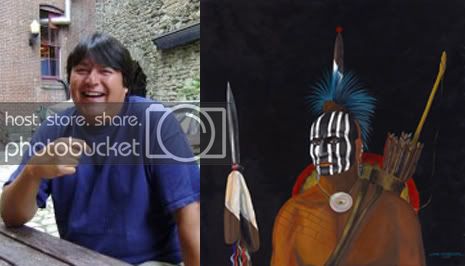
Joe Don Brave says he has worked his whole life for something of the caliber of the exhibit in Paris. Born in 1965, he was named Vincent Paul Brave after Vincent Van Gogh and Paul Gauguin by his father, Franklin Brave, a professional artist and graphic designer. One day his father nicknamed him Joe Don after Oklahoma football star Joe Don Looney. That nickname stuck.
As a child Brave learned to paint in his father’s studio. Brave studied art at the Institute of American Indian Arts in Santa Fe, N.M., and has worked at the National Museum of American Indian and the Smithsonian Institute in New York City. He also owns his gallery in downtown Pawhuska, Okla.
Brave was raised in the traditions and customs of the Osage, and he’s still an active participant in the tribe’s annual traditional ceremonial dances.
Anita Fields (Osage)

Anita Fields, born in 1951 and raised in Hominy, Okla., is one of a few American Indian potters who does not live in the Southwest where the many pueblos, Hopi and Navajo dominate that medium.
Fields is probably the first Indian potter to create conceptual installation pieces instead of functional or display pottery. To make her artistic statement she often uses abstract versions of traditional clothing and artifacts. Influenced by American Indian clothing and weaving, she translates these soft features into her hard clay works.
She says her work honors women: “The dresses convey my attitudes toward the strength of women and how native peoples show remarkable resourcefulness and adaptability toward their environment. The clothing Indian women created shows great pride, dignity, and hope in a culture facing insurmountable odds.”
Yatika Fields (Osage)
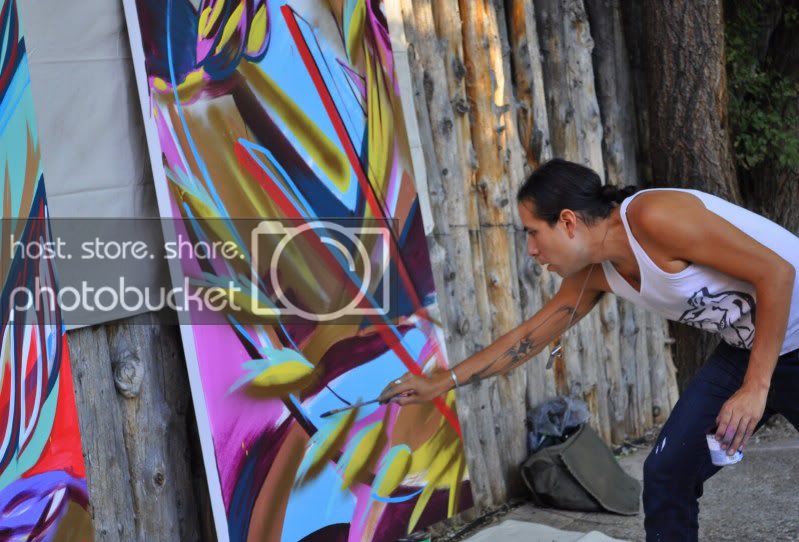
Born in 1980 to Anita Fields, the artist featured just above, Yatika Fields grew up in Oklahoma but currently lives in Brooklyn.
After living in Boston with bike messengers he developed a passion for cycling. He moved to New York without any cash and got a job in the dangerous occupation of city bike messengering. That’s riding a bike with a fixed gear and NO brakes. After realizing he was pretty fast he ventured into alleycats, illegal street racing where the only prize is honor.
Here is a terrific VIDEO of Fields painting a wall in the apartment Ryan Red Corn (Osage).
His work is currently exhibited at Chiaroscuro Contemporary in Santa Fe, Sam Noble Museum in Norman, Okla., and The Heard Museum in Phoenix, Ariz. Last October he was in Barcelona for three weeks doing live painting events and then in Paris in November where he enjoyed traveling with his mother.
Brent Greenwood (Chickasaw/Ponca)
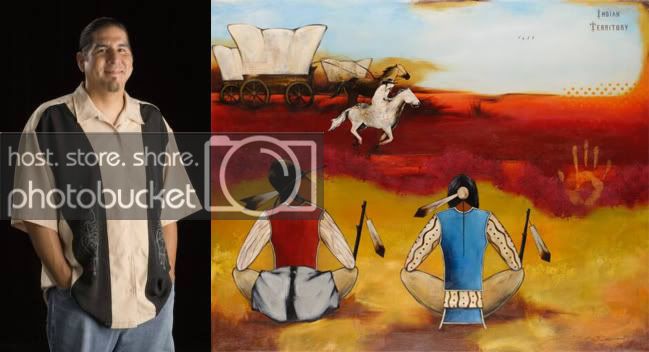
Brent Greenwood was born in 1971 in Midwest City, Okla.. He graduated with an AFA in 2-Dimensional Art from the Institute of American Indian Arts and a BFA from the Oklahoma City University.
Greenwood incorporates early tribal history into his contemporary acrylic designs, often with faceless figures but vibrant with color. Some of his artistic inspiration is derived from other artists’ work and energy. He is most proud of his family and the inspiration they provide. His wife Kennetha (Otoe/Missouria) is an artist as well. Greenwood encourages his children to paint alongside him. He enjoys singing Ponca songs at events and shares this spirit with his children and other youth in his community.
America Meredith (Cherokee)

America Meredith, also of Swedish descent, “blends traditional styles from Native America and Europe with pop imagery of her childhood. The Cherokee language and syllabary figure prominently in her work, as they are the strongest visual imagery unique to her tribe.”
Meredith “earned her MFA in painting from the San Francisco Art Institute and her BFA from the University of Oklahoma. She has shown throughout the United States and in Canada and Europe in the last 15 years and has won awards at the Heard and SWAIA’s Indian Market as well as at numerous competitive shows” and now featured in Paris.
Her on-line portfolio is an absolute treat, and my favorite page is Present Tense. Check out The Tewa Man in Black, illustrating the importance of corn to American Indians and Cameron Chino, an Indian full-blood who loves the Japanese culture.
A stunning international art exhibit inviting the tight-knit bike messenger community to use its spokecard is the Cherokee Spokespeople Project. “Spokecards are laminated cards that can be held in place by the spokes of a bicycle wheel, which bike messengers create as souvenirs for bike races and other messenger events.”

The Cherokee language has a unique writing system developed by Sequoyah in the early 1800s and still used today. All American Indian languages are struggling to survive. “According to Cherokee Nation tribal leadership, our current generation, the fourteenth generation since European contact with the Cherokees, is said to be the generation that decides whether the language grows or dies.” So to promote the Cherokee language, Meredith made spokecards available to the bike-messengering community and asked them to document the card on their bikes with a photograph featuring a famous location. Participants received a custom card from Meredith with their choice of any word in Cherokee to display on their bike. Sometimes, words were invented for the prize winners, creating new Cherokee words.
To survive, Cherokee cannot be stuck in the past or confined to one part of the country. Cherokee Spokespeople are introducing new people to their language and bringing it into an international, urban setting.
“This project continued from 2004 to 2011. [Meredith] distributed hundreds of spokecards by hand, at SFBMA meetings, at cycle courier races, and through the mail. The Cherokee Spokespeople Project has been exhibited at the Art Gallery of Southwestern Manitoba in Brandon, Manitoba, Canada; IAIA Museum in Santa Fe, New Mexico; the Euphrat Museum in Cupertino, CA; the City Arts Center in Oklahoma City, OK; and was finally exhibited as a solo show at the Ho-Chee-Nee Chapel on the grounds of the Cherokee Heritage Center in Park Hill, OK.”
Navarre Scott Momaday (Kiowa/Cherokee)
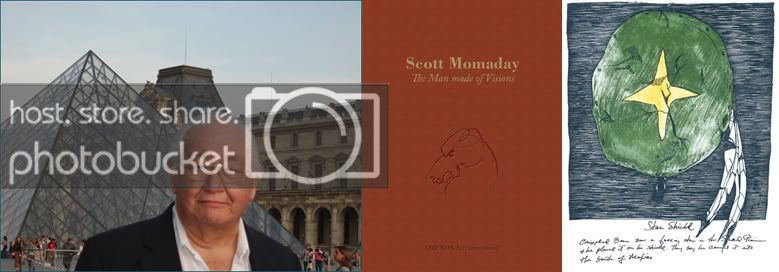
N. Scott Momaday, born in 1934 in Lawton, Okla., is a Pulitzer Prize-winning writer. Momaday’s novel House Made of Dawn is credited for launching Native American literature into the mainstream. It won the Pulitzer Prize for Fiction in 1969.
He received the first Lifetime Achievement Award from the Native Writers’ Circle of the Americas in 1992. He was awarded a 2007 National Medal of Arts and received an honorary Doctor of Humane Letters from the University of Illinois at Chicago in 2010.
In Paris, Momday’s book The Man Made of Visions, a dozen unpublished poems and signed lithographs were featured. Thumbnails of the lithographs can be seen here.
Thomas Poolaw (Kiowa/Delaware)

Born in 1959 and currently residing in Norman, Okla., Tom Poolaw works primarily with acrylics and digital images. He was heavily influenced by his grandfather, Horace Poolaw, a photographer.
He prefers to let his work unfold rather than knowing what it will look like at the finish. “Process is the focus of my work. I choose formats and situations that encourage spontaneity and experimentation. The journey must be exciting and inspired. I want to produce something nearer to poetry than documentation.
“My work usually deals with Native American subject matter expressed in a contemporary manner. It doesn’t always have to, but that’s who I am and where I come from. I hope the work reflects the status of today’s Native American individual, that is complex, modern and spiritual.”
Marla Skye (Onondaga)
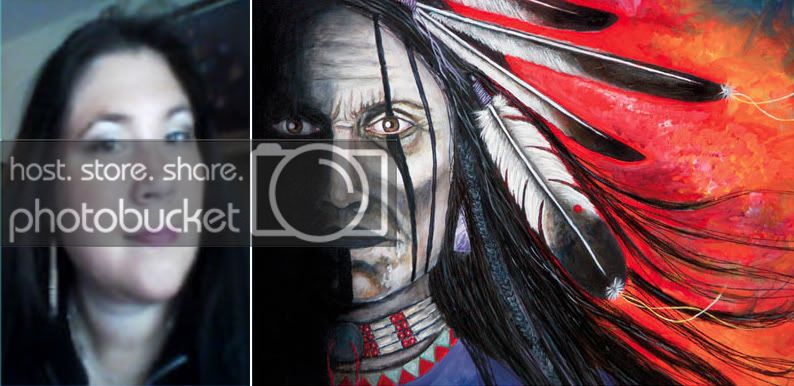
Marla Skye works with several mediums, painting, silversmithing, beading and woodcarving. Her father, Larry Jones, was a skilled woodcarver and artist. He died just two months before her showing in Paris. He was thrilled that she was going to be featured there. Skye is a graduate of The Institute of American Indian Arts in Santa Fe, N.M.
D.g. Smalling (Choctaw)
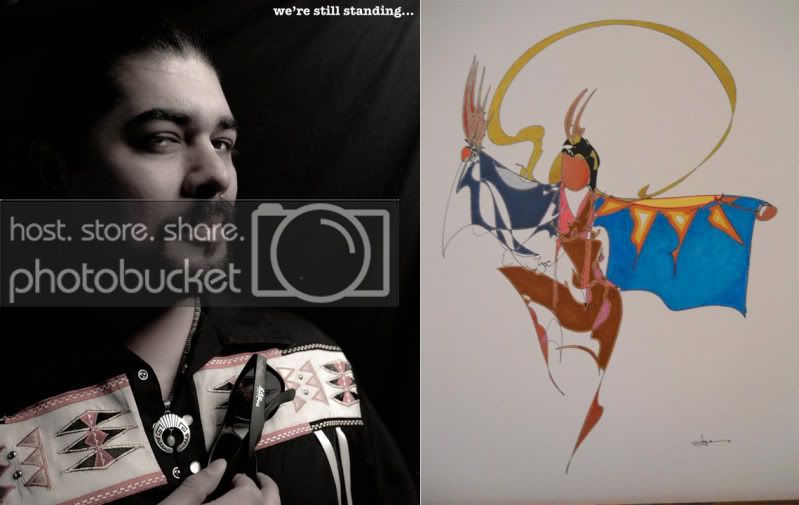
D.g. Smalling was born and raised in Oklahoma City. He is known for his “single line” art in which he creates the initial outline never lifting his pen. He then fills in the spaces with color. This amazing and beautiful technique is captured in this VIDEO.
He credits his Choctaw culture whose traditions and lifestyle embrace minimalism. His abstractions begin with the most basic element-the line-the foundation of all design.
The pieces he produced for the Paris exhibit are here.
Smalling hosts The Spy’s Eye on NDN-Country on thespyfm.com, Saturday mornings from 9 a.m. to 10 a.m., Central Time.
Dana Tiger (Creek/Seminole/Cherokee)
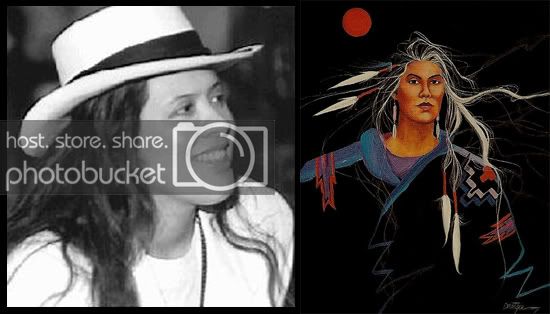
Dana Tiger was born and raised in Muskogee, Okla. Her legendary father, Jerome Tiger died when she was five years old. She used his art as a way to get to know him and along with guidance from her uncle, Johnny Tiger, Jr. From them, she learned the richness of her culture and carried on the family’s artistic tradition. Her watercolors and acrylic paintings celebrate the strength and determination of American Indian women.
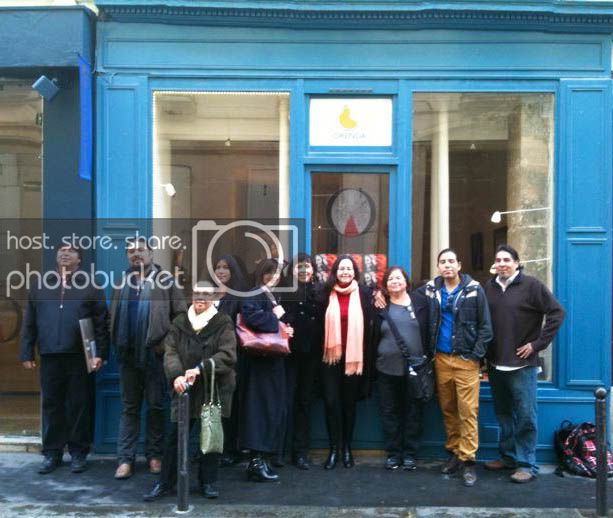
And since it is the Grand Palais, pour le pièce de résistance … a grand nod to curator Russell Tallchief (Osage). He gathered these 11 artists in the Salon du Dessin et de la Peinture à l’eau (Room of Painting and Water Colors) at the Grand Palais. As a special treat, on Nov. 24, 2011, he performed an ancient southern style of Osage war dance. He is a Straight Dancer and performed as a Taildancer, a privileged position that serves to set the pace and motivate the other performers to dance harder. The dance symbolizes being on the battlefield.
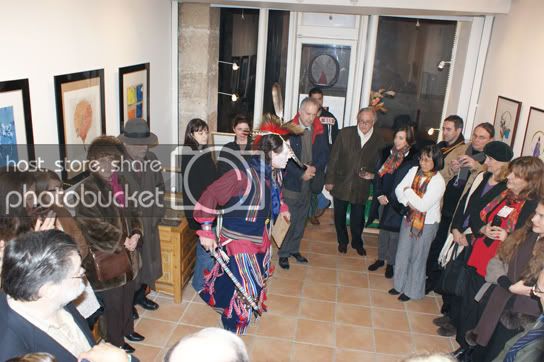
Tallchief is related to the renowned ballerinas Maria Tallchief (born 1925) who danced with the New York City Ballet and Marjorie Tallchief (born 1927) who was the first American to achieve première danseuse étoile with the Paris Opera Ballet.
The exhibit was viewed by over 40,000 visitors.

1883 ‘Civilizing’ Code Smashed Religion, Culture, Social Relations
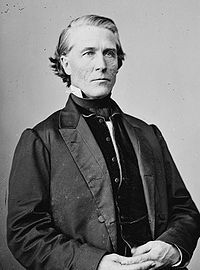
of Indian Affairs 1881-1885
By Meteor Blades
On April 10, 1883, Secretary of Interior Henry Teller approved the Code of Indian Offenses that would henceforth be handled by the new Court of Indian Offenses, the predecessor of today’s tribal courts. The rules of the code were developed by former Iowa Congressman Hiram Price, a “radical Republican” who had been appointed by President James Garfield to the post of Commissioner of Indian Affairs in 1881.
It should be remembered that this was a time when Indians, most of whom did not become U.S. citizens until 1924, were not permitted to leave their reservations except by consent and written approval of their superintendent.
For nearly two years, Price had lobbied his boss to extend state and territorial jurisdiction over Indian reservations. There was dissembling about the purpose of this. He said Congress should enact laws to “make the Indian equally secure with the white man in his individual rights of person and property, and equally amenable for any violation of the rights of others.” But behind those seemingly reasonable words about equal protection and equal responsibility was a sinister effort to knuckle Indians under again, demolishing their religious, cultural and social practices. In other words, ethnocide.
Price presented his proposed rules to Secretary Teller in December 1882, and Teller approved them the following April. Among the true purposes, Price wrote, was “to destroy the tribal relations as fast as possible.” Just as when the Office of Indian Affairs (soon renamed the Bureau of Indian Affairs) was established in 1824, the imposition of the rules was done by fiat of the Secretary of Interior, without congressional action. That would not occur until 1885 when Congress passed the Major Crimes Act.
The rules set forth a Court of Indian Offenses at each Indian agency. Each court was to be presided over by a tribunal, the Indian judges automatically being the three highest-ranking officers of the tribal police. Appeals would be handled by the BIA. An amendment in 1894 allowed judges to be chosen from among other tribal members.
The rules had little to do with laws established to regulate the behavior of non-Indians. With a couple of exceptions, they were more like status crimes, that is, if you’re Indian, you can’t do this without getting into trouble-worshiping as you please or drinking alcohol, for example.
With only minor changes the rules remained in place until 1935, when Secretary of Interior Harold Ickes promulgated fresh regulations as a consequence of the Indian Reorganization Act of the previous year. Here are excerpts from the nine rules set forth in 1883:
• 1st. Establishes the court and selection of judges, each for a one-year term. “[N]o person shall be eligible to appointment as a member of said court who is a polygamist; and provided further, that the judges herein provided for shall receive no money consideration on account of their services in connection with said court.”
• 2d. Requires two regular sessions a month, the time approved by the local (government-appointed) Indian agent (who was a private contractor).
• 3d. Authorizes the agent to “compel the attendance of witnesses at any session of the court, and enforce, with the aid of the police, if necessary, all orders that may be passed by the court or a majority thereof; but all orders, decrees, or judgments of the court shall be subject to approval or disapproval of the agent, and an appeal to and final revision by this office…”
• 4th. “The ‘sun-dance,’ the ‘scalp-dance,’ the ‘war-dance,’ and all other so-called feasts assimilating thereto, shall be considered ‘Indian offenses,’ and any Indian found guilty of being a participant in any one or more of these ‘offenses’ shall, for the first offense committed, be punished by withholding from the person or persons so found guilty by the court his or their rations for a period not exceeding ten days; and if found guilty of any subsequent offense under this rule, shall by punished by withholding his or their rations for a period not less than fifteen days, nor more than thirty days, or by incarceration in the agency prison for a period not exceeding thirty days.”
• 5th. “Any plural marriage hereafter contracted or entered into by any member of an Indian tribe under the supervision of a United States Indian agent shall be considered an ‘Indian offense,’ [… and] shall pay a fine of not less than twenty dollars, or work at hard labor for a period of twenty days, or both, at the discretion of the court. […] and so long as the Indian shall continue in this unlawful relation he shall forfeit all right to receive rations from the Government. And whenever it shall be proven to the satisfaction of the court that any member of the tribe fails, without proper cause, to support his wife and children, no rations shall be issued to him until such time as satisfactory assurance is given to the court, approved by the agent, that the offender will provide for his family to the best of his ability.”
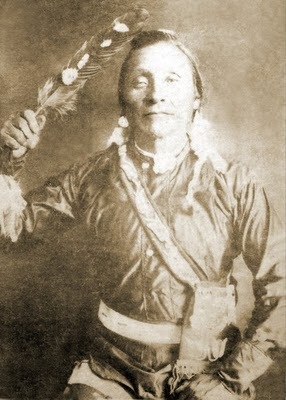
Spokane Reservation for continuing to practice
traditional ceremonies in violation of the Code of
Indian Offenses. He was acquitted because the
main witness against him failed to show up in court.
(Courtesy of Barry Moses, his great-great grandson)
• 6th. “The usual practices of so-called ‘medicine-men’ shall be considered ‘Indian offenses’ […] and whenever it shall be proven to the satisfaction of the court that the influence or practice of a so-called ‘medicine-man’ operates as a hindrance to the civilization of a tribe, or that said ‘medicine-man’ resorts to any artifice or device to keep the Indians under his influence, or shall adopt any means to prevent the attendance of children at the agency schools, or shall use any of the arts of a conjurer to prevent the Indians from abandoning their heathenish rites and customs, he shall be adjudged guilty of an Indian offense, and upon conviction of any one or more of these specified practices, or, any other, in the opinion of the court, of an equally anti-progressive nature, shall be confined in the agency prison for a term not less than ten days, or until such time as he shall produce evidence satisfactory to the court, and approved by the agent, that he will forever abandon all practices styled Indian offenses under this rule.”
• 7th. Requires restoration or restitution for theft or destruction of property. “Those convicted shall be confined in the agency prison for a term not exceeding thirty days; and it shall not be considered a sufficient or satisfactory answer to any of the offenses set forth in this rule that the party charged was at the time a ‘mourner,’ and thereby justified in taking or destroying the property in accordance with the customs or rites of the tribe.”
• 8th. “Any Indian or mixed-blood who shall pay or offer to pay any money or other valuable consideration to the friends or relatives of any Indian girl or woman, for the purpose of living or cohabiting with said girl or woman, shall be deemed guilty of an Indian offense, and upon conviction thereof shall forfeit all right to Government rations for a period at the discretion of the agent, or be imprisoned in the agency prison for a period not exceeding sixty days; and any Indian or mixed-blood who shall receive or offer to receive any consideration for the purpose herein before specified shall be punished in a similar manner as provided for the party paying or offering to pay the said consideration; and if any white man shall be found guilty of any of the offenses herein mentioned he shall be immediately removed from the reservation and not allowed to return thereto.”
• 9th. The court also has jurisdiction over misdemeanors and civil suits among Indians “and any Indian who shall be found intoxicated, or who shall sell, exchange, give, barter, or dispose of any spirituous, vinous, or fermented liquors to any other Indian, or who shall introduce or attempt to introduce, under any pretense whatever, any spirituous, vinous, or fermented liquors on the reservation, shall be punishable by imprisonment for not less than thirty day nor more than ninety days, or by the withholding of Government rations therefrom, at the discretion of the court and approval of the agent.”
The imposition of these rules, finalized in 1884, was spurred by the U.S. Supreme Court in Ex Parte Crow Dog (1883). The Court ruled that despite explicit extension of U.S. jurisdiction over “certain bands of Sioux Indians” in 1877, they were subject to U.S. law not as citizens entitled to equal protection under the law and the rights guaranteed by the U.S. Constitution, but as “wards subject to a guardian … as a dependent community who were in a state of pupilage.” Although laws at the time were clear about crimes committed by Indians against non-Indians and vice versa, they did not specify what to do about crimes committed by Indians against Indians. Therefore, the court ruled that Crow Dog’s killing of Spotted Tail was a matter solely for tribal jurisdiction.
As a consequence, in 1885, Congress passed the predecessor to today’s (Indian) Major Crimes Act, which Commissioner Price called a “step in the right direction.” The act established seven major crimes on the reservations as a matter for federal as opposed to tribal jurisdiction. These were (and remain today): murder; manslaughter; rape; assault with intent to commit murder; arson; burglary; and larceny. Crimes in which the maximum sentence is one year or less are still handled by many tribal courts.

U.S. Deal for Navajo-Hopi Water Has Familiar Stench
(First of a series.)
By Aji
“Steals Water.”
That should be U.S. Sen. Jon Kyl’s “Indian name.” It would also fit Sen. John McCain, Rep. Ben Quayle and Rep. Paul Gosar.
What these four, with the apparent collaboration of the formal leadership of the Navajo and Hopi nations, have been plotting recently has the potential to become the biggest theft of natural resources from American Indians in years.
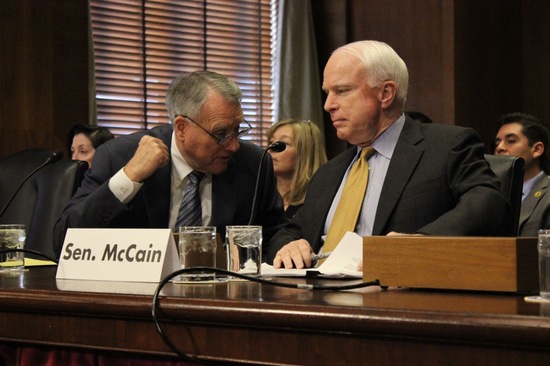
The bill, S-2109 (HR-4067 in the House), is known informally as the Navajo-Hopi Little Colorado River Water Rights Settlement Act of 2012. The text defines its purpose as follows:
To approve the settlement of water rights claims of the Navajo Nation, the Hopi Tribe, and the allottees of the Navajo Nation and Hopi Tribe in the State of Arizona, to authorize construction of municipal water projects relating to the water rights claims, to resolve litigation against the United States concerning Colorado River operations affecting the States of California, Arizona, and Nevada, and for other purposes.
In reality, it’s the latest in a line of swindles in the nation’s long history of grabbing tribal resources and telling Indians it’s for their own good.
The bill’s true purpose is to coerce the Navajo and Hopi into surrendering all their rights to the Little Colorado River, the area’s major water source. Kyl, McCain, et al. are offering what amounts to a bribe in the form of much-needed and long-delayed groundwater-delivery projects for the two tribes. In exchange for those two limited-term projects, each tribe would permanently surrender all future claims to Little Colorado River water rights, and would waive all rights to future litigation in the event of damages arising in any way from the settlement agreements.

The indemnity goes only one way, of course. It’s only the Indians who are barred from suing the state, the federal government and its agencies and the private corporations who stand to benefit most from the diversion of this precious tribal resource. And it turns out that the groundwater delivery projects may be nothing more than a mirage: The funding allocation is limited and appears to be conditioned on the assumption that certain monies, which may or may not exist, will be used.
Those terms alone should have gotten the Republican members of Arizona’s congressional delegation laughed out of the room, out of town, out of state, and all the way back to their insular D.C. offices.
Instead, it appears that a non-Indian lawyer on the staff of the Navajo Nation Department of Justice, with the apparent blessing (some tribal members might say “connivance”) of Navajo Nation President Ben Shelly and Hopi Tribal Chair LeRoy Shingoitewa, “negotiated” this monstrosity with Kyl and McCain and their staffers without authorization from the Navajo Nation Tribal Council. Stanley Pollack, the NNDOJ lawyer, has been on staff for years and reputedly has experience with water rights issues. But many tribal members believe he and others involved intended to help Shelly to help Kyl and McCain ram through the legislation before anyone got wise. Since tribal grassroots environmental organizations caught wind of the scheme, they and individual members of both tribes have begun vocal protests.
Once it became apparent that the bill could not be passed quietly, Kyl and McCain made a trip to Tuba City in the heart of the Navajo Nation, ostensibly to meet with tribal representatives. It was, in fact, intended to be a private meeting, behind closed doors, with only Shelly and Shingoitewa and their staff members in a strategy session to try to salvage the bill more or less in its current form. That failed miserably. Some 200 protestors from both nations, including former tribal chairs and officers, demonstrated outside the meeting.

Navajo Police formed a human cordon, and allegedly physically abused former Navajo Nation President Milton Bluehouse as he tried to enter the building. Eventually, Shelly emerged to try to reassure tribal members that they and the tribal council would have the final word. But his attempt to soothe everyone was met with jeers, catcalls, demands to “kill the bill” and open accusations of “selling out.”
The “sellout” label has only gained traction with reports that Shelly’s administration has hired lobbying firm Brownstein Hyatt. One of its lead lobbyists in this matter is Ryan Smith-a former Senate aide to Jon Kyl. No word yet on who, if anyone, will be lobbying for the Hopi.
Kyl and McCain, of course, “dismiss” the people’s criticisms as just so much “misinformation” while they continue to pressure both tribes to approve the bill amid vague but dire warnings that time is somehow short.
Time is short for the 70-year-old Sen. Kyl. He’s retiring at the end of this year after 18 years in the Senate. That leaves him just a few months to bestow this particular windfall upon his political benefactors: specifically, mostly non-Native corporate interests, including the Navajo Generating Station, Peabody Western Coal and the Salt River Project. The latter was one of Kyl’s corporate clients before he entered Congress. The bill would also benefit Arizona’s non-Indian residents and other business interests.
Next Week: An analysis of the legal aspects of the case. In future pieces we will examine the many toxic currents-including sovereignty, autonomy, self-representation, politics, media and cultural theft-of contemporary “Indian policy” that have converged into the proposed Little Colorado River Settlement.
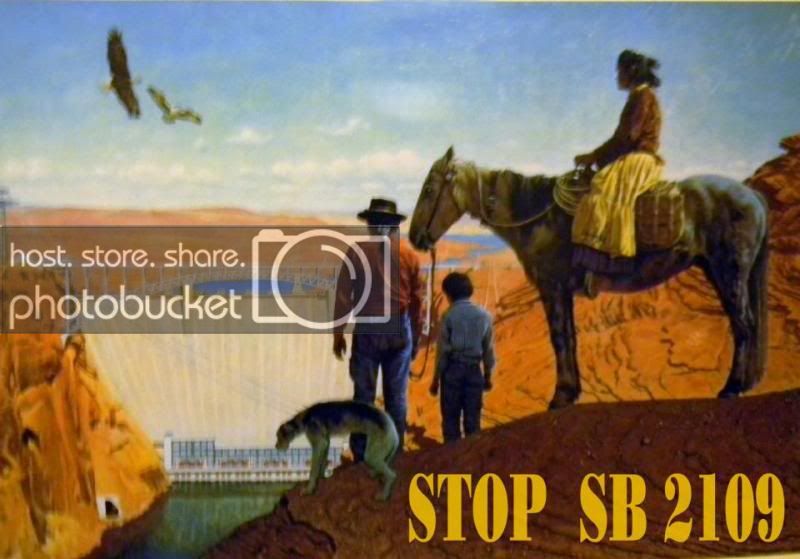

Feds Settle Century of Rip-offs with $1 Billion to 41 Tribes
By Meteor Blades
In just over three years, the Obama administration has done more for American Indians than any administration since Lyndon Johnson called for an end of termination policy 44 years ago. A good deal of that has to do with simply being a good listener. But the administration is also building a solid record of compensating the tribes for decades of government bungling and behavior that, labeled properly, was outright theft.
The latest move, announced April 11, is the billion-dollar settlement with 41 tribes from Maine to California. Funding does not have to be approved by Congress because it has already been allocated in the Judgment Fund. The settlement ends a 22-month-long negotiation between the tribes and the United States over more than a century of mismanagement of concessions granted to non-Indians by the departments of Interior and the Treasury. Interior oversees 56 million acres of Indian land held in trust by the government. The concessions cover various resources, including minerals, timber, oil and gas, and grazing rights.
“They literally could not tell the tribal beneficiary how much money was in the account, or how much money was in it or where it was going,”says Matthew Fletcher. […]
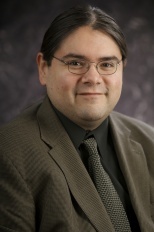 Matthew Fletcher
Matthew Fletcher“You know there’s sort of a moral trust responsibility of the federal government to Indian tribes. And that plays a key role,” Fletcher says. “That’s why you have press conferences with the attorney general saying ‘We’re doing the things that we should have been doing 50 years ago or 100 years ago.’”
Fletcher, a member of the Grand Traverse Band of Ottawa and Chippewa Indians, teaches indigenous law at Michigan State University and is director of the MSU College of Law’s Indigenous Law and Policy Center.
The agreement is in addition to the $3.4 billion settlement over trust-land mismanagement in a class-action lawsuit brought by the late Elouise Cobell, aka Yellow Bird Woman (Niitsítapi-Blackfoot Confederacy). The Cobell settlement covered cases brought by 300,000 individual Indians. That settlement is being appealed in federal court.
The federal government settled with the Osage for $380 million in October and $760 million in the Keepseagle v. Vilsack case in 2010. The latter was brought by individual American Indian farmers and ranchers in a class-action suit against the U.S. Department of Agriculture. They accused the department of discrimination in administering loan programs.
“These important settlements reflect President Obama’s continuing commitment to ensuring empowerment and reconciliation for American Indians,” said Secretary [of the Interior Ken] Salazar. “It strengthens the government-to-government relationship with Tribal nations, helps restore a positive working relationship with Indian Country leaders and empowers American Indian communities.”
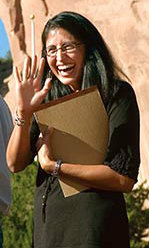
On hand for the event was Hilary Tompkins (Navajo), Solicitor General of the Interior Department. She helped work out the details of the settlement. “[W]hen I say the word trust, I don’t mean the legal definition of that word, I mean the dictionary’s definition of that word-assured reliance on the integrity, veracity, justice, friendship, or other sound principle of a person or thing […] May we walk together toward a brighter future, built on trust, and not acrimony,” she said.
All tribes have had a dark relationship with the federal government, said Gary Hayes, chairman of the Ute Mountain Ute Tribe, whose reservation covers southwest Colorado, southeast Utah and northern New Mexico. But the settlements will assist tribal governments in supplementing decades of inadequate funding throughout Indian Country, helping to improve public safety, infrastructure and health care, he said.
“The seeds that we plant today will profit us in the future and continue for generations to come,” Hayes said.
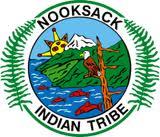
The Ute Mountain Utes will receive nearly $42.6 million of the settlement. A government spokesman said the Feds would not announce specific amounts, but leave that up to the individual tribes’ discretion. Known amounts range from the $150 million going to the Confederated Salish and Kootenai Tribes of Montana to the $25,000 for the Nootsack Tribe of Washington state. In addition to the 41 lawsuits settled in the agreement, another 71 are still in litigation.
The tribes receiving a portion of the $1.023 billion settlement are:
Assiniboine and Sioux Tribes of the Fort Peck Reservation; Bad River Band of Lake Superior Chippewa Indians; Blackfeet Tribe; Bois Forte Band of Chippewa Indians; Cachil Dehe Band of Wintun Indians of Colusa Rancheria; Coeur d’Alene Tribe; Chippewa Cree Tribe of the Rocky Boy’s Reservation; Confederated Tribes of the Colville Reservation; Confederated Salish and Kootenai Tribes; Confederated Tribes of the Siletz Reservation; Hualapai Tribe; Kaibab Band of Paiute Indians of Arizona; Kickapoo Tribe of Kansas; Lac du Flambeau Band of Lake Superior Chippewa Indians; Leech Lake Band of Ojibwe Indians; Makah Tribe of the Makah Reservation; Mescalero Apache Nation; Minnesota Chippewa Tribe; Nez Perce Tribe; Nooksack Tribe.
Northern Cheyenne Tribe; Passamaquoddy Tribe of Maine; Pawnee Nation; Pueblo of Zia; Quechan Indian Tribe of the Fort Yuma Reservation; Rincon Luiseño Band of Indians; Round Valley Tribes; Salt River Pima-Maricopa Indian Community; Santee Sioux Tribe; Shoshone-Bannock Tribes of the Fort Hall Reservation; Soboba Band of Luiseño Indians; Spirit Lake Dakotah Nation; Spokane Tribe; Standing Rock Sioux Tribe of the Fort Yates Reservation; Swinomish Indian Tribal Community; Te-Moak Tribe of Western Shoshone Indians; Tohono O’odham Nation; Tulalip Tribe; Tule River Tribe; Ute Mountain Ute Tribe; Ute Tribe of the Uintah and Ouray Reservation.

Stereotypes Celebrated for Privileged Children Birthday Party Idea
By navajo
Many things bother me about a blog page of party designer Kara Allen promoting her new book, Kara’s Party Ideas. The page is called Native American Party. Kara uses typical stereotypes Indian people have been fighting for decades and celebrates them as proper for impressionable young children. She has 38 photos illustrating every aspect of her partyscape. Here are the ones that bother me the most:
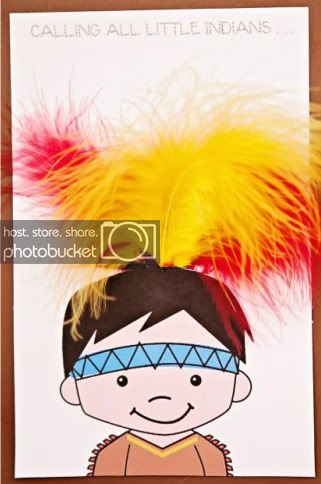

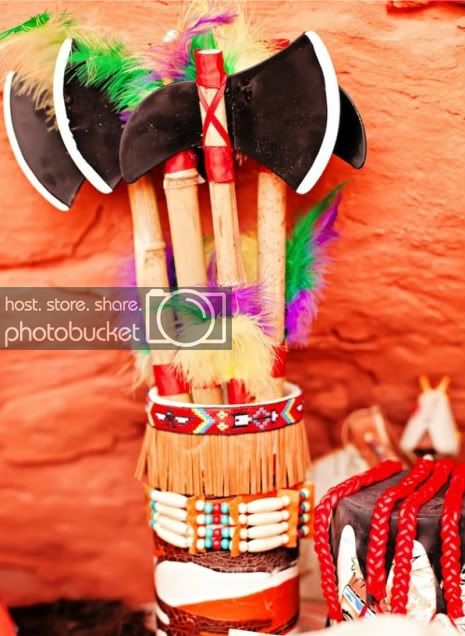
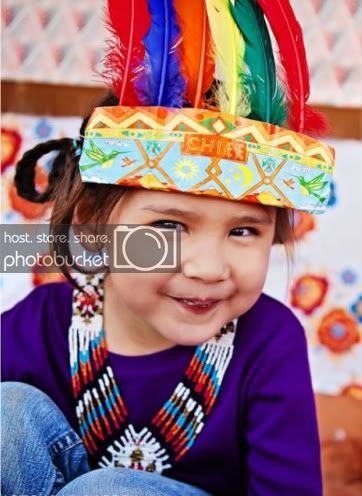
Calling All Little Indians?????
Plains Indian costume?????
Tomahawks and red licorice braids?????
Chief?????
Gah.
Fortunately, there are respectful criticisms (the nasty ones are gone now) in the comment section of her blog page explaining why the use of stereotypes is racist. But the replies from Kara and her supporters bother me.
Kara offers one of those “sorry if anyone was offended” apologies:
I just want to apologize. I had no intention of being disrespectful to any race or ethnicity. I have the highest regard for the Native American culture, in fact, my husband is part Cherokee. I meant the party as a way to honor the Native American heritage {just as a “Luau Party” honors the Samoan, Hawaiian, Tongan, etc. cultures} while also celebrating a birthday in a fun way.
Kara’s perspective falls into the category of ignorant racism. How exactly does this theme differ from a “blackface” party? Would Kara promote that on her blog?
Kara writes that she lives in Utah, my birth state, which was once all Indian land. Land belonging to the Bannock, Goshute, Navajo, Paiute, Shoshone and Ute tribes. All very different tribes. Tribes whose traditional clothing doesn’t resemble the costumes at Kara’s party. Except for the Navajo, these tribes were forced onto small reservations long ago.
I wonder if Kara can name any of these Utah tribes and describe a few aspects of their different cultures. I wonder if she knows there are different bands within some of those tribes. I grew up in Utah and I’ve visited nearly all the reservations there. It was visually obvious to me even as a young child that they have higher poverty rates than the rest of Utah.
It’s disturbing to know the reality of the living conditions on our reservations and then see a stereotyped depiction of generic Indians flaunted as a party.
Personally, I don’t think the advice in the comments for taking one tribe and “honoring” them at a privileged child’s birthday party is a good approach. Better to remove this page from the upcoming book. Kara should stick to her other fantasy ideas as party themes.
American Indians are not a fantasy.

• Seattle School of Law Debuts American Indian Law Journal: Backed by the Center for Indian Law & Policy, the 96-page journal, whose cover art appears below, contains articles titled, among others: “Can Indian Tribes Sell or Encumber Their Fee Lands Without Federal Approval?”; “The Public Nature of Indian Reservation Roads”; and “Justice Rehnquist’s Theory of Indian Law: The Evolution from Mazurie to Atkinson – Where Did He Leave the Court?”
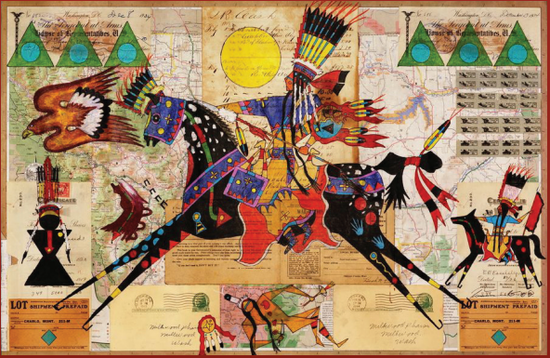
-Meteor Blades
• Miccosukee Indians Allege Lawyers Ripped Them Off: The 600-member tribe has accused former Miami U.S. Attorney Guy Lewis and ex-federal prosecutor Michael Tein of luring it “into unnecessarily paying millions of dollars in legal fees that were excessive and unreasonable, for work that was fictitious, improperly created, unsubstantiated and which did not achieve any reasonable benefit.” Millions of dollars paid out to the two lawyers built the pair a lavish lifestyle that included, among other things, a huge luxury car collection and a zeppelin.
-Meteor Blades
• S.D. State Rep. Ed Iron Cloud (Oglala Lakota ) Missed Filing Deadline for Primary: The Democratic incumbent state representative from Porcupine missed the deadline to submit petitions for running as a Democrat in the state primary June 5, but he plans to run as an independent and is gathering signatures to do so. South Dakota has 35 legislative districts, each represented by one senator and two House members. Iron Cloud has represented South Dakota’s heavily Democratic District 27 since 2009 along with Kevin Killer (Oglala Lakota). If he doesn’t make the ballot, Killer and Republican Elizabeth May will automatically get seats in the House.
-Meteor Blades

Aboriginal Transgender Wins Fight to Compete in Miss Universe Canada Contest: A member of the Nat’oot’en (or Lake Babine) First Nation of British Columbia, Jenna Talackova was born male. At 19, four years ago, she had a sex-change operation. And now she is a 23-year-old woman competing in the Canadian Miss Universe Pageant. Three weeks ago, however, the Donald Trump-controlled pageant disqualified her for being formerly male, and Talackova decided to fight back, enlisting Los Angeles attorney Gloria Allred in the battle. Which generated some heated words. Allred asked Trump to prove he is a man, and Trump fired back that she would be impressed if she saw his junk. On April 2, the pageant agreed that Talackova can compete as long as she meets Canadian “legal gender recognition requirements” and the standards of other international competitions. The latter may be difficult since some of those, including the Miss USA pageant, require a contestant to be a “naturally born genetic female.” Transgender advocates saw the win as a partial victory. Suzi Parker at the Washington Post granted that Talackova should have the right to compete, but asked why she would want to given Parker’s view that it would be better if no women desired pageant queen status.
-Meteor Blades
• National Native News Offers First Nations Radio Briefs Each Day: The operation is celebrating its 25th anniversary this year as a provider of five minutes of radio news each day about American Indians, Alaskan Natives and First Nations peoples of Canada. Programming is available to Native and non-Native outlets. You can also listen on line.
-Meteor Blades
• Gov. Brian Schweitzer Honored at 31st Annual Montana Indian Education Association Conference: The association honored the governor Friday in Bozeman for his leadership in Indian education. Among the prominent members of Montana’s Indian community in attendance was Carol Juneau (Mandan/Hidatsa), a former Montana senator. She spoke about the positive impact Schweitzer has had. Her daughter, Denise, is the state’s Superintendent of Public Instruction, the first Indian ever elected to statewide office in Montana. Schweitzer spoke of the importance of education in bringing down reservation unemployment rates that are six or more times the national average.
-Meteor Blades
• Banks Won’t Supports Reservation Contractors for Lack of Collateral: Among the obstacles faced by reservation-based construction companies bidding to work on large construction projects is that fact that the reservation cannot use land to take out bonds to fund projects. That is because reservation land is trust land and not taxed by the federal government. “Banks won’t come anywhere near the reservation,” said Dustin Twiss (Oglala Lakota), who with his father lost a bid on a communication system for a new justice facility on the Pine Ridge Reservation. “You’d be lucky to make a payday loan, let alone a half a million dollar bond down here, unless you have 100 percent of the assets.”
-Meteor Blades
• Petitioners Seek Access to “Plan B” Emergency Contraception for Native Women: A recent report by the Native American Women’s Health Education Resource Center showed that 90 percent of American Indian women have a very difficult time getting emergency contraception because the vast majority of Indian Health Service pharmacies don’t carry it. For reservation women, who often live in rural areas, the next nearest pharmacy may be 100 miles away. You can sign a petition urging IHS Director Dr. Yvette Roubideaux to issue a directive to all IHS service providers to make emergency contraception available on demand without a prescription or doctor visit to all women 17 or older.
-Meteor Blades (with h/t to Land of Enchantment)
• Sanford School Teams, No, Not THAT Sanford, Call Themselves “Redskins” : A high school in the Maine town of 21,000 has yet to get rid of the nickname or its stereotypical mascot. Of the 448 students, faculty and staff at the school, only about 40 percent support

changing the name, the last school in the state whose teams are called “Redskins.” Maine Indian Tribal-State Commission has asked the school’s governing committee to get rid of it. Wiscasset, a Maine town of 3600, dumped the name at its high school last year. Other less incendiary Indian-themed nicknames are still used by some schools in the state. About 50 Indians and non-Indians got together in Sanford on Wednesday for “a peace-building conversation.” Richard Silliboy, tribal councilor of the Aroostook Band of Micmacs, said the “R” term is just as insulting as “squaw,” a word that has been removed from all public place names in Maine. Silliboy said he’d taken many insults in his life: “Dirty Indian, stinkin’ Indian, drunken Indian” and a “no-good-for-nothing Indian and the only good Indian’s a dead Indian.” The school committee meets next month to decide whether to change the name and get rid of its logo of a stereotypical Indian in a stereotypical Plains-style “war bonnet.” That other Sanford? The high school has “Sammy Seminole,” a stereotyped very unSeminole mascot dropped in favor of “Chief Osceola” by Florida State University years ago. (Full Disclosure: The latter FSU mascot is approved by the Seminole Tribe of Florida in which I am an enrolled member.)
-Meteor Blades
• A Sacred Peak With Rich Ore Deposits: Chicago Peak is a place associated with the creation of the Kootenai world. “It’s one of the most significant sites to the Kootenai because of its association with knowledge and power,” says Maria Nieves Zedeño, an anthropologist who has studied the peak’s importance to the Confederated Salish and Kootenai Tribes of Montana. They seek to have the peak listed on the National Register of Historic Places. They hope this might spotlight a mining company’s plans to burrow beneath it and haul out its silver and copper. The listing would not legally stop the company from going ahead with its Rock Creek Mine, however. The tribe traditionally uses the spiritual site for praying, fasting and seeking visions.
-Meteor Blades (h/t to BentLiberal)
• 1300-Year-Old Indigenous Stone Structure Preserved by New Heritage Park: Massachusetts became home to the new Upton Heritage Park Sunday (today) and that means protected status for a stone structure built by indigenous people 13 centuries ago. Site lines in the structure, a chamber that archeologists believe was part of a series of ceremonial buildings, align perfectly with the summer solstice for the year 710 CE.
-Meteor Blades (h/t to ojibwa)
• Criminal Justice Training Initiative Begins in Cherokee Nation: The Justice and Interior Departments have completed the first in a series of national level training courses, “Criminal Jurisdiction in Indian Country.” The courses are designed to strengthen the ability of tribal and local law enforcement to participate in the investigation and enforcement of federal crimes in Indian country and fulfill a key training requirement under the Tribal Law and Order Act of 2010. Thirty-five class participants representing seven tribes in Oklahoma and one county sheriff’s office took part in the three-day CJIC training. Topics included training in federal Indian law criminal jurisdiction, how to best serve sexual assault and domestic violence victims, as well as the investigation and enforcement of drug and firearm offenses.
-Meteor Blades
• Marty Two Bulls Wins Society of Professional Journalists’ Cartooning Award: The Oglala Lakota, editorial cartoonist for Indian Country Today, has won a Sigma Delta Chi award from the SPJ for his acerbic work. The award is divided among cartoonists at publications of 100,000 circulation or more and those of less than 100,000. Matt Bors, who cartoons appear regularly at Daily Kos, won the award for the larger circulation publications. Two Bulls lives on the Pine Ridge Reservation: “My father is Rev. Robert Two Bulls and my grandfather was Peter Two Bulls Sr. I hail from the Red Shirt Table area of our reservation. Our enemies call us the Sioux.”
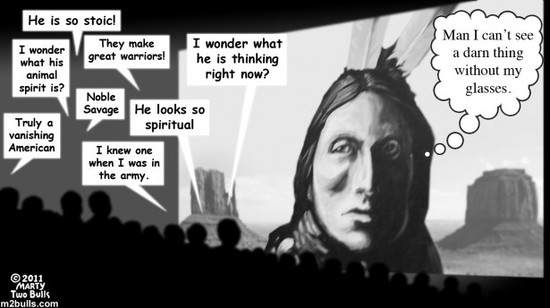
Indians have often been referred to as the “Vanishing Americans.” But we are still here, entangled each in his or her unique way with modern America, blended into the dominant culture or not, full-blood or not, on the reservation or not, and living lives much like the lives of other Americans, but with differences related to our history on this continent, our diverse cultures and religions, and our special legal status. To most other Americans, we are invisible, or only perceived in the most stereotyped fashion.First Nations News & Views is designed to provide a window into our world, each Sunday reporting on a small number of stories, both the good and the not-so-good, and providing a reminder of where we came from, what we are doing now and what matters to us. We wish to make it clear that neither navajo nor I make any claim whatsoever to speak for anyone other than ourselves, as individuals, not for the Navajo people or the Seminole people, the tribes in which we are enrolled as members, nor, of course, the people of any other tribes.


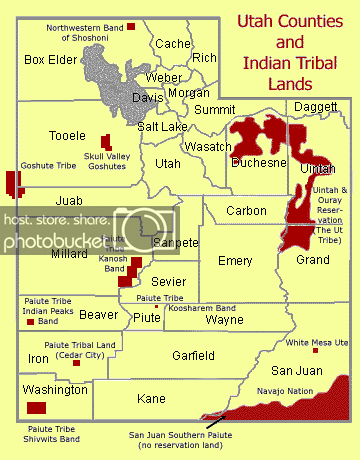

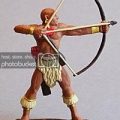
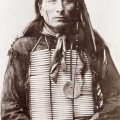
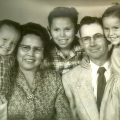
Leave a Reply